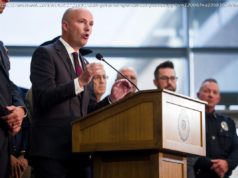Ministers in Theresa May’s cabinet quit over her proposed Brexit plan, and hardline members in her own party are trying to force a « no confidence » vote.
Two ministers have resigned from UK Prime Minister Theresa May’s cabinet, throwing her government into chaos and threatening the future of a proposed Brexit deal.
Brexit Secretary Dominic Raab and Work and Pensions Secretary Esther McVey both handed in their resignation on Thursday, less than 24 hours after May said she had secured cabinet approval for a draft Brexit agreement. These high-profile departures come as the United Kingdom and European Union attempt to hash out the terms of the UK’s exit — or “Brexit” — after Britons voted in a June 2016 referendum to leave.
The two sides have until March 29,2019, to reach an agreement and get it ratified by both parliaments. On that date, the UK’s membership in the EU will expire, deal or no deal, with potentially catastrophic results: air travel in the UK could grind to an immediate halt, British supermarkets could run out of food… the list goes on .
May, and the EU, are desperately trying to avoid a no-deal scenario. After months of stalled negotiations, the two sides finally thought they had reached a breakthrough this week that solved some of the thorniest issues of the divorce, and provided for a transition period so they could work out a future trade deal.
On Wednesday, May called her new draft plan the “best agreement that could be negotiated,” and the apparent backing of her cabinet cleared the way for it to move forward.
But the latest dramatic resignations reveal the obstacles that May faces in finalizing the withdrawal. May’s Conservative party is split between hardliner “Brexiteers,” who want a clean break with the European Union, and others who are angling for a less disruptive, “softer” Brexit, which would involve closer ties with the EU.
The “hard” Brexit camp was agitating against May’s latest proposed Brexit deal before the text had even been released. They see it as a betrayal, and they fear it will leave Britain subject indefinitely to the rules and regulations of the EU.
May is still moving forward with the draft agreement, saying it’s basically this or nothing — but it will be difficult since factions within her own party, and the opposition Labour party, have opposed it. She’s also up against a significant leadership challenge, as hardliners are calling for a “no confidence” vote.
May insisted at a press conference on Thursday that, despite the challenges, she’s going to see this deal through. But it’s clear these latest resignations have thrown everything into turmoil.
“Right now we’re in a moment of high uncertainty, but I wouldn’t fully discount the current Brexit deal,” Abraham Newman, a political scientist at Georgetown’s Walsh School of Foreign Service, told me. “This is like a high Game of Thrones, or House of Cards moment where the hard Brexiteers are trying to leverage their power.”
Britons voted, 52 to 48 percent, to “leave” the European Union in June 2016. Those who campaigned for a Brexit argued that the UK would regain its sovereignty, including more control over its territory when it came to migration.
The “Remain” camp — those who wanted to stay within the EU — saw this as somewhat wishful thinking, and argued that extracting the UK from its decades-long membership in the bloc would be a cumbersome, unpredictable process.
That has proved to be the case since May, in March 2017, formally trigged Article 50, a part of the Lisbon Treaty that governs the EU, to initiate the exit process from Europe. That set off a two-year timeline to reach a Brexit deal, with the deadline set for March 29,2019.
The core question in these negotiations is which (if any) EU treaties and laws will continue to apply to the UK after it’s left. But while that may sound fairly simple, it’s anything but.
And one of the biggest hurdles to negotiating a deal with the EU is that the UK government itself first has to decide what kind of relationship it wants the country to have post-divorce.
The two competing visions for what that relationship should look like are usually referred to as “hard Brexit” and “soft Brexit.”
In this scenario, the UK envisions a clean break with the EU, and would then try to negotiate some sort of free trade deal with the EU. The UK gains control over things like immigration and borders, but it also loses the perks of being part of the European Union single market and customs union, which eliminate tariffs and many other trade barriers for EU member states.
That arrangement would make the more hardcore anti-immigration Brexiteers happy but would also likely be incredibly disruptive to businesses and the country’s economy.
A “soft” Brexit involves a much less severe break with the EU. Broadly speaking, the UK would stay close to the EU and retain access to the single market and customs union. This would soften the blow to the British economy when Brexit becomes official, and it’s something Remainers — though they never wanted to leave in the first place — tend to favor if Brexit has to happen.
The caveat, though, is that the UK would also have to abide by many of the EU laws and regulations that govern the single market and customs union. And since it would no longer be an EU member, the UK would have little or no say in what those rules are or how they’re applied.
Hard Brexiteers hate this approach because they consider it to be a Brexit in name only that would fail to restore the UK’s full sovereignty over its own affairs and leave the country at the whims of decision-makers in Brussels, where the EU is headquartered.
May’s Conservative Party is sharply divided between those who favor a hard Brexit and those who prefer some sort of agreement that eases the UK out of the EU. And it’s because of this split that May is facing resistance from her own party over this latest Brexit draft deal, which they don’t see as sufficiently Brexit-y enough.
The whopping nearly 600-page draft Brexit deal, published Wednesday, tackles exactly how, and when, the EU and the UK will break up. Here are some of the key takeaways:
A transition period to figure out a future a UK-EU trade deal
This proposed withdrawal agreement calls for a 21-month transition period, until December 31,2020, where all of the UK will remain in single customs territory as the EU and the UK work out this new trade relationship, though the transition period can be extended past 2020 date.
A “backstop” safeguarding an open border between Ireland and Northern Ireland
Most critically, this plan provides a safeguard solution to the Irish border question — which had previously brought the UK and EU negotiations to a standstill. The UK’s membership in the EU helped preserve an open border between Northern Ireland (which is part of the UK) and the Republic of Ireland (which is part of the EU).
This is a critical pillar of the 1998 Good Friday Agreement, which ended decades of sectarian conflict in Northern Ireland between the largely Protestant population who wanted to stay within the UK, and Catholics, who identified more closely with the Republic of Ireland.
Brexit threatened this open border and the past two decades of relative peace, so both sides agreed to include a “backstop” — basically, a guarantee that even if the EU and the UK don’t reach a trade agreement, an open border between Northern Ireland and Ireland will remain in place, no matter what.
The “backstop plan” will call for the entire UK to stay in the EU customs union for goods. But Northern Ireland will still remain within some parts of the EU single market, which means it will have to follow somewhat stricter regulatory standards compared to the rest of the UK.
This has created a brand-new Brexit metaphor: the “ swimming pool .” Think of Northern Ireland in the deep end, having to follow more EU regulations, and the rest of the UK in the shallow end, with less stringent rules.
The UK will also have to follow this arrangement until an independent panel is assured there’s no chance of any return to a hard Irish border, but it can’t unilaterally withdraw from the setup.
The status of millions of EU citizens living in the UK and UK citizens living in the EU
Broadly speaking, EU nationals who’ve lived in the UK for five years can remain with their families. Britons will also be allowed to stay in the EU country where they currently live.
Divorce settlement
This is how much the UK will pay the EU for forcing everyone to go through this whole process. This is expected to be at least 39 billion pounds, which is about $50 billion.
An outline for future negotiations
There is also a short political declaration attached to the withdrawal agreement that offers the broad guidelines for the future EU-UK relationship, which will be hammered out after the UK formally leaves the EU on March 29.






